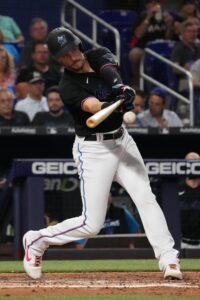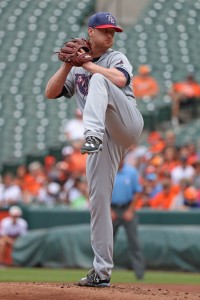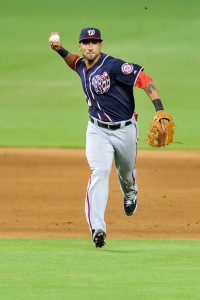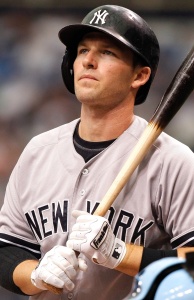There seems to be a holdup in the market for left-handed relievers. Though pitchers like Taylor Rogers and Matt Strahm have signed deals, others like Andrew Chafin, Matt Moore and Zack Britton are still out there. Ken Rosenthal of The Athletic recently wrote about the situation, listing 10 clubs that were interested in that trio of available lefties. But that means at least seven clubs will miss out on that group and will need to consider other options, with one of those being Brad Hand.
Hand, 33 in March, had a dominant run in the second half of the last decade but seems to have aged into a different kind of pitcher in the past few years. From 2016 to 2020, he made 306 appearances with a 2.70 ERA, striking out 33.3% of batters faced while walking 8.1% and getting ground balls at a solid 41.2% clip. That strikeout rate was third among relievers with at least 250 innings in that time, trailing only Edwin Diaz and Kenley Jansen.
Those punchouts got away from him in 2021, as his rate dropped all the way down to 21.9%. He kept his ERA at a respectable 3.90 for the season, though was clearly not at the same level as years prior. He signed with the Phillies for 2022 and saw his rate stats continue in the wrong direction, though with better results overall. He tossed 45 innings last year, striking out just 19.2% of opponents and walking 11.6% of them. However, he was able to find ways to limit the overall damage and finished the year with a 2.80 ERA.
Whether that limiting of damage was skill or luck is a matter of debate. Hand’s batting average on balls in play last year was 2.71, slightly better than his .284 career mark and the .289 league average last year. It’s a similar situation with his strand rate, which was 75.9% last year, just ahead of the 72.6% league average and his 73.6% career rate. That perhaps points to a bit of good fortune, and advanced metrics were unanimous in thinking Hand deserved worse, such as a 3.93 FIP, 4.40 xERA and 4.51 SIERA. He also only allowed two home runs on the year, a difficult feat to repeat.
But it does seem as though Hand is doing something to keep hitters off balance. Among the 444 pitchers with 100 or more batted ball events last year, Hand’s average exit velocity of 87.2 mph came in 93rd. His rate of barrel per BBE was 88th, barrels per plate appearance 77th, while his 26.9% hard hit rate was fourth. In that latter category, he trailed only Lucas Luetge, Brusdar Graterol and Caleb Thielbar, and was just ahead of Devin Williams, Jason Adam, Ryan Tepera and Tyler Anderson.
This all might hinge on his slider, which is his primary pitch. He’s thrown it more than any other pitch in each season since 2017, per Statcast data. He used to get huge swing-and-miss numbers off it, with a whiff rate over 40% in three straight years from 2017 to 2019. However, that dipped to 38.6% in 2020 and then 27.9% and 22% over the past two seasons. That lack of whiffs hasn’t translated into more significant contact, however. The pitch had a hard hit rate of 29.5% in 2019 but he lowered that to 16.9% in 2022. Opponents hit just .222 against the pitch last year and slugged .321, with Hand using the slider 52.1% of the time.
It’s perhaps a function of the diminished power he has on the pitch, which he threw in the 81-85 mph range from 2016 to 2019 but has been more 79-80 in the past three years. It also has a bit less spin, as he got his RPM up to 2629 in 2017 but has dropped in subsequent years, with 2022’s spin rate coming in at 2282 RPM. That’s resulted in missing fewer bats but hitters aren’t doing much damage when they do make contact.
With less whiffs, Hand’s contact rate has naturally gone up in kind. While batters made contract on 71% of his pitches from 2016-2020, it’s been 81.7% in the past two years. But it seems as though that extra contact is coming outside the strike zone. His Z-contact rate was 82.4% during those prime years and ticked up to 87% over the past two. But his O-contact rate, for pitches outside the zone, jumped to 71% in the past two seasons after being at 53.6% in his peak years. Hitters are swinging at those pitches outside the zone a bit less, which correlates with Hand’s increased walk rate last year, but it’s possible hitters are just turning some of Hand’s whiffs into weak contact.
What teams will have to decide is whether Hand has been making this happen or merely getting away with something. He’s been working with diminished stuff in recent years but has found ways to avoid disaster, with that 3.90 ERA in 2021 and 2.80 last year. Pitching to contact is a risky proposition but Hand has found ways to make it work. The upcoming ban on defensive shifts could theoretically make it even more risky, though Hand only pitched in front of a shifted defense 20.8% of the time last year, below the 33.6% league average. If metrics like FIP, xERA and SIERA are right, he’s due for some regression, but he’s kept his ERA below those numbers two years in a row now. Perhaps he’d be best suited to a club that has strong faith in its defense and pitcher-friendly ballpark, with the Cardinals jumping out as a nice fit. But his market has been quiet this winter and Spring Training kicks off in just over a week.




